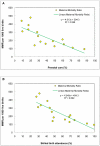Economic inequalities in maternal health care: prenatal care and skilled birth attendance in India, 1992-2006
- PMID: 21048964
- PMCID: PMC2965095
- DOI: 10.1371/journal.pone.0013593
Economic inequalities in maternal health care: prenatal care and skilled birth attendance in India, 1992-2006
Abstract
Background: The use of maternal health care is limited in India despite several programmatic efforts for its improvement since the late 1980's. The use of maternal health care is typically patterned on socioeconomic and cultural contours. However, there is no clear perspective about how socioeconomic differences over time have contributed towards the use of maternal health care in India.
Methodology/principal findings: Using data from three rounds of National Family Health Survey (NFHS) conducted during 1992-2006, we analyse the trends and patterns in utilization of prenatal care (PNC) in first trimester with four or more antenatal care visits and skilled birth attendance (SBA) among poor and nonpoor mothers, disaggregated by area of residence in India and three contrasting provinces, namely, Uttar Pradesh, Maharashtra and Tamil Nadu. In addition, we investigate the relative contribution of public and private health facilities in meeting the demand for SBA, especially among poor mothers. We also examine the role of salient socioeconomic, demographic and cultural factors in influencing aforementioned outcomes. Bivariate analyses, concentration curve and concentration index, logistic regression and multinomial logistic regression models are used to understand the trends, patterns and predictors of the two outcome variables. Results indicate sluggish progress in utilization of PNC and SBA in India and selected provinces during 1992-2006. Enormous inequalities in utilization of PNC and SBA were observed largely to the disadvantage of the poor. Multivariate analysis suggests growing inequalities in utilization of the two outcomes across different economic groups.
Conclusions: The use of PNC and SBA remains disproportionately lower among poor mothers in India irrespective of area of residence and province. Despite several governmental efforts to increase access and coverage of delivery services to poor, it is clear that the poor (a) do not use SBA and (b) even if they had SBA, they were more likely to use the private providers.
Conflict of interest statement
Figures




Similar articles
-
Maternal health care service utilization among young married women in India, 1992-2016: trends and determinants.BMC Pregnancy Childbirth. 2021 Feb 10;21(1):122. doi: 10.1186/s12884-021-03607-w. BMC Pregnancy Childbirth. 2021. PMID: 33568078 Free PMC article.
-
Inequalities in the utilization of maternal health care in the pre- and post-National Health Mission periods in India.J Biosoc Sci. 2020 Mar;52(2):198-212. doi: 10.1017/S0021932019000385. Epub 2019 Jun 24. J Biosoc Sci. 2020. PMID: 31232249
-
Decomposing maternal socioeconomic inequalities in Zimbabwe; leaving no woman behind.BMC Pregnancy Childbirth. 2022 Mar 23;22(1):239. doi: 10.1186/s12884-022-04571-9. BMC Pregnancy Childbirth. 2022. PMID: 35321687 Free PMC article.
-
Maternal Health Situation in Bihar and Madhya Pradesh: A Comparative Analysis of State Fact Sheets of National Family Health Survey (NFHS)-3 and 4.J Clin Diagn Res. 2016 Sep;10(9):IE01-IE04. doi: 10.7860/JCDR/2016/19079.8404. Epub 2016 Sep 1. J Clin Diagn Res. 2016. PMID: 27790466 Free PMC article. Review.
-
A Review of the National Family Health Survey Data in Addressing India's Maternal Health Situation.Public Health Rev. 2022 Oct 31;43:1604825. doi: 10.3389/phrs.2022.1604825. eCollection 2022. Public Health Rev. 2022. PMID: 36387421 Free PMC article.
Cited by
-
Does having a mobile phone matter? Linking phone access among women to health in India: An exploratory analysis of the National Family Health Survey.PLoS One. 2020 Jul 20;15(7):e0236078. doi: 10.1371/journal.pone.0236078. eCollection 2020. PLoS One. 2020. PMID: 32687527 Free PMC article.
-
Using community informants to estimate maternal mortality in a rural district in Pakistan: a feasibility study.J Pregnancy. 2015;2015:267923. doi: 10.1155/2015/267923. Epub 2015 Feb 9. J Pregnancy. 2015. PMID: 25741446 Free PMC article.
-
Examining the effect of household wealth and migration status on safe delivery care in urban India, 1992-2006.PLoS One. 2012;7(9):e44901. doi: 10.1371/journal.pone.0044901. Epub 2012 Sep 7. PLoS One. 2012. PMID: 22970324 Free PMC article.
-
Enablers and Barriers to the Utilization of Antenatal Care Services in India.Int J Environ Res Public Health. 2019 Aug 29;16(17):3152. doi: 10.3390/ijerph16173152. Int J Environ Res Public Health. 2019. PMID: 31470550 Free PMC article.
-
Fertility intentions and maternal health behaviour during and after pregnancy.Popul Stud (Camb). 2020 Mar;74(1):55-74. doi: 10.1080/00324728.2019.1672881. Epub 2019 Nov 6. Popul Stud (Camb). 2020. PMID: 31690185 Free PMC article.
References
-
- Ronsmans C, Graham WJ. Maternal Mortality: who, when, where and why? Lancet. 2006;368:1189–200. - PubMed
-
- Rosenfield A, Maine D. Maternal Mortality- a neglected tragedy: where is the M in MCH? Lancet. 1985;2:83–85. - PubMed
-
- Freedman L, Wirth M, Waldman R, Chowdhury M, Rosanfield A. Background paper of the task force on child health and maternal health. Millennium Project. Commissioned by UN Secretary General and supported by UN Development Group. 2003. Available: http://www.unmillenniumproject.org/documents/tf04apr18.pdf. Accessed 2010 April 23.
-
- United Nations Children's Fund (UNICEF) The State of the World's Children Report-Maternal and Neoborn Health. New York, USA: 2008.
-
- Freedman LP, Graham WJ, Brazier E, Smith JM, Ensor T, et al. Practical lessons from global safe motherhood initiatives: time for a new focus on implementation. Lancet. 2007;370:1383–91. - PubMed
Publication types
MeSH terms
Grants and funding
LinkOut - more resources
Full Text Sources
Medical

